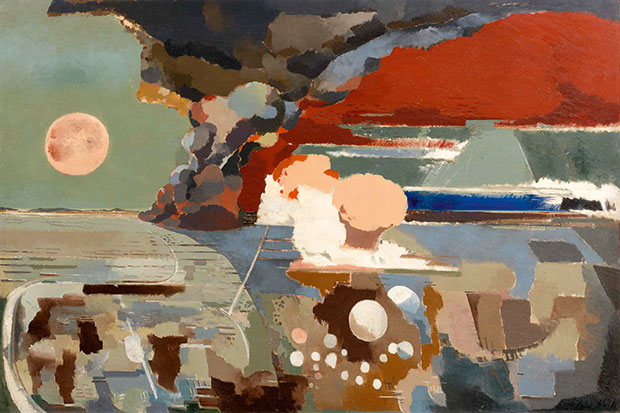In 1932 Paul Nash posed the question, is it possible to ‘go modern’ and still ‘be British?’ — a conundrum that still perplexes the national consciousness more than 80 years later. It is true that the artist himself answered that query with an emphatic ‘yes’. But, as the fine exhibition at Tate Britain makes clear, his modernism was deeply traditional.
The truth is that Nash (1889–1946) was what the author Alexandra Harris has termed a ‘romantic modern’. In other words, his art was a characteristic Anglo-Saxon attempt to have things both ways. Equally typically, he managed to do so — but only some of the time.
Nash’s early drawings and watercolours, done in his early twenties, reveal his starting point. Most are landscapes of his native Buckinghamshire and, in one case, ‘Wittenham Clumps’ (1913), an Iron Age hill fort near Didcot that continued to haunt Nash’s imagination for the rest of his life. He was instinctively attuned to the uncanny sense of presence he found in such objects as eroded stones and bits of gnarled wood; on the other hand, Nash was hopeless with human beings, who more or less disappear from his art after the first few years.
In many ways, Nash might seem backward-looking, preoccupied as he was with the poetic and mystical overtones of places such as Avebury stone circle. But his antiquarianism did not prevent a romance with the artistic cutting edge. In the late 1930s he came across a corner of farmland littered with fallen trees resembling dragons or dinosaurs, which he dubbed ‘Monster Field’. This was the subject of some remarkable photographs and slightly anaemic watercolours (Nash was distinctly hit-and-miss as a painter). Monster Field was a set of surrealist found objects, in an English landscape mode.
For all his romanticism, Nash was a keen follower of the latest developments across the Channel. For a while he attempted rather timid experiments with abstraction — such as ‘Coronilla’ (1929) — and had a longer flirtation with surrealism, reading avant-garde magazines while tucked away in Rye. This interest was more fruitful, producing engaging, if quirky, results including a rare, recently rediscovered Nash sculpture, ‘Moon Aviary’ (1937).
An intriguing section of the exhibition investigates the byways of English surrealism, but much of the best work in it is by other artists such as Eileen Agar and Tristram Hillier, who were following a parallel track. Even the more successful of Nash’s paintings in this vein, such as ‘Event on the Downs’ (1934) — with a giant tennis ball set against distant white cliffs — seem forced. The blend he was attempting — two parts John Sell Cotman to one part René Magritte — didn’t really cohere.
Surrealists were preoccupied by the subconscious, eroticism and perversity, whereas the weirdness of England was Nash’s true subject. He once declared the town of Swanage an example of ‘seaside surrealism’ — perhaps rightly — but one suspects that the idea would have come as a surprise to Max Ernst.
Around the same time, he wrote The Shell Guide to Dorset — commissioned by John Betjeman — with an unexpected focus on the savage, ancient and primitive aspects of that county: the ‘vicious’ seas around its coasts, fossils of prehistoric creatures, and remains at Maiden Castle of a Roman massacre. In this little book Nash, it seems, may have been inspired by the thoughts of Georges Bataille, a Parisian numismatist who in his spare time advocated an aesthetic based on cruelty and barbarism.
On the face of it, Bataille might seem an unsuitable guru for Nash — or any romantic Briton. Yet it was the cataclysm of the two world wars that brought out the best in Nash as an artist, propelling him from the engagingly eccentric into the front rank of British painters — one of the few who stand out between the death of Turner in 1851 and the rise of Francis Bacon in the late 1940s.
His first moment of greatness came after he enlisted in the Artists’ Rifles, and was sent on active service to the Western Front in 1917, succeeded by a spell as an official war artist. Out of this terrible experience came a number of powerful pictures and one out-and-out masterpiece: ‘We Are Making a New World’ (1918). This is a sublime landscape in the northern romantic tradition of Caspar David Friedrich and Turner concerned with death, destruction and transcendence. The trees have been shattered by high explosive, the earth convulsed, but the sun is rising again over distant hills.
After the war, Nash was emotionally drained; he found a parallel to his inner sense of numbness in the flat and empty expanses of the coast at Dymchurch. He did not hit his absolutely top form again until the time of the Battle of Britain. ‘Totes Meer’ (1940–1), depicting the wreckage of German planes stored in an outdoor dump near Cowley, is eerily magnificent. ‘Battle of Germany’ (1944), with the sky blooming with smoke and flames and dotted with parachutes opening like flowers, is almost visionary.
In the last few years before he died of asthma, Nash produced a superb series of landscapes. These return to his beginnings — several depict Wittenham Clumps again — but deepened by the explorations and experiences that come in between. Pictures such as ‘November Moon’ (1942) and ‘Landscape of the Vernal Equinox’ (1943) are neither old-fashioned nor modern, but wonderfully mellow, rich and strange.






Comments